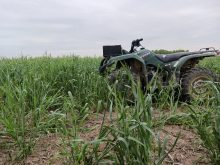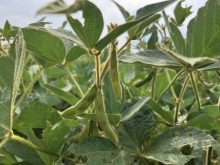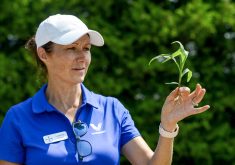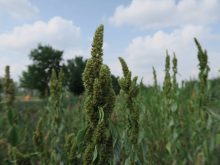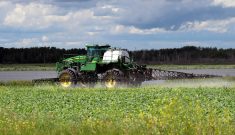Scrutiny of crop spraying continues to increase and off-target movement or drift can affect yield and become an annoyance growers would rather avoid.
Why it matters: Understanding how drift can occur and dealing with it if it happens can minimize crop loss and keep neighbours happy.
“I’m not representing any enforcement agency, but if there is a drift issue, you want to know what it looks like and determine how you resolve it,” says Tom Wolf, owner of Agrimetrix Research and Training in Saskatoon.
Read Also

The forced Japanese-Canadian farmers of the Second World War
Manitoba’s sugar beet farms drew on displaced Japanese-Canadians from B.C. during the Second World War
“That’s really the question we’re trying to answer: What would you do as someone who’s been drifted on?”
Wolf provided insights on drift complaints and damage, his role in investigations and research into how and why chemical products drift. He spoke at the Ontario Soil and Crop Improvement Association’s annual meeting Feb. 7 in Elora.
The classic picture of drift has visible sign of damage, usually upwind of a susceptible crop. It may be annoying and some words may be exchanged between owners.
But the good news, based on Wolf’s investigations and research, is that most scenarios do not cause an economically significant loss across a whole field.
A step back
The bulk of Wolf’s presentation involved explanations about drift damage to susceptible crops and clearer definitions surrounding those incidents.
There are many potential causes of crop damage, including phytotoxic herbicide and susceptible crop combinations.
“That’s just basic agronomy and there’s no list of things I can provide here,” said Wolf. “You just have to dig into your agronomic knowledge.”
Second on his “to do” list is to understand that damaged fields must be either downwind or downhill from an application. Drift cannot move uphill or upwind.
A third consideration is the pattern of damage, where drift deposit dissipates rapidly with distance. That occurs because most spraying is done during the day and in breezy conditions.
“That’s a good thing and limits the damage because there’s a lot of dilution in the atmosphere and the spray cloud goes up and down, and deposits out very quickly,” said Wolf.
In estimating potential damage, he conducted a composite of 21 different studies using varying boom heights and nozzles, which helps determine the pattern of damage. Starting with the spray boom, he measured how much product reached the target and how much moved one, two and five metres away and from five to 120 metres away.
He found that an average 82 per cent of applied product was on target. The first two metres downwind captured 15 per cent. Beyond two metres and up to five metres it was one per cent and from five to 120 metres it dropped to 0.3 per cent. The remaining 1.7 per cent dissipated into the atmosphere.
Dicamba drift
In 2017, the dicamba-based product XtendiMax was introduced and the subject of drift or off-target movement changed dramatically. That year, in parts of the U.S. Midwest, there were 2,708 dicamba drift incidents documented with a state authority.
According to Wolf, they were often unresolved and the actual number of cases was higher and unreported.
“The covered area exceeded 3.6 million acres of drift complaints in 2017,” he said, noting the average size of each complaint was 1,328.4 acres.
“That’s more than one drift complaint, so there were a lot that were not reported.”
Unfortunately, dicamba damage is highly specific and visible. Cupping of leaves, particularly in soybeans, is a clear indication.
Wolf and his Sprayers 101 partner, Jason Deveau, also talked at the recent Ontario Agricultural Conference about the use of drones for spraying herbicides.
Those applications are illegal in Canada, although they’re frequently carried out in the U.S., and there is evidence of the same practice in parts of Ontario and the West.
How to find the cause of drift
Wolf said there are a number of potential causes for crop damage and urged attendees to explore all possibilities in their search for the cause.
1. Talk to neighbours. Keep communicating, especially if you’re angry. There might be a reason your neighbour is doing what they’re doing or it could be an honest mistake.
2. Consult with an independent agronomist; someone without any stake in the economics of the farm, who can also help with documentation.
3. Sample plants and freeze half for subsequent analysis. Make sure of your record keeping. It might show that you weren’t on the field in question.
4. Monitor crop progress for symptoms, delayed maturity and height measurements. In spite of visual injury, the crop may grow out of its apparent damage.
5. Obtain weather records. If you don’t have a weather app, Environment Canada can help with weather data such as temperatures, relative humidity, wind direction and speed.
6. Measure yield. It can be complicated and contentious to gather yield data from affected parts and non-affected parts of a field but that comparison is vital.
7. Stay reasonable. Sometimes crop injury happens to you and sometimes you cause it.






